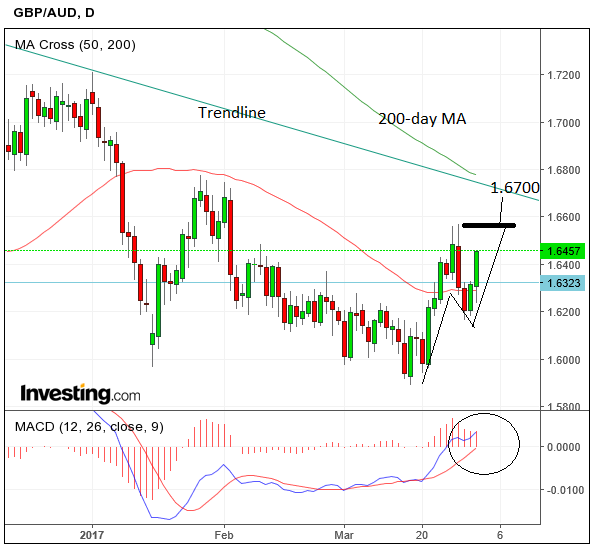GBP/AUD: Week-Ahead Forecast

Our multi-day analysis of the GBP/AUD chart has us believing the pair has a bias to strengthen further after the recovery from the mid-March lows.
A break above the 1.6571 highs would probably confirm an extension up to the trendline at roughly 1.6700.
But that trendline, combined with the 200-day moving average nearby, are expected to cap further gains and would require a strong driver to break through.
We note that the MACD is popping above the zero-line potentially providing a bullish signal too.

The Pound to Australian Dollar exchange rate has seen something of a rebound since the March 16 lows at 1.58 were tested and is currently trading around 1.6457.
The Pound's strength might appear strange given the UK triggered article 50 during this time, ushering in a period of extreme uncertainty during EU-UK negotiations but markets actually breathed a sigh of relief last week as initial communications appeared cordial.
A large factor in the Pound’s strong rally was that a ‘Hard’ Brexit now appears less likely, however, there are likely to be many twists and turns on the journey to disunion and we have already witnessed several sticking points crop up already, the highest profile of which is the Spanish attempt at a veto of the principality of Gibraltar leaving the EU along with Britain.
On the Aussie side of the coin, the outlook is dim as most analysts see iron ore, its largest export, falling in price not just for one, but for a whole host of reasons.
It is the end of the restocking season while there is also the government curb on commodities speculation in China, the slowing Chinese property market and the increasing preference for high-grade Brazilian iron ore over Aussie ore because it causes less pollution - a major issue now in smog-ridden Chinese cities.
“Iron ore prices have also fallen, which means the Reserve Bank has less to be optimistic about in April. If it shrugs off these reports and remains positive, AUD will continue to outperform. However if RBA finally admits that the outlook may not be so bright, AUD/USD could come off its highs,” says Kathy Lien of BK Asset Management.

Balanced against this is a view that while iron ore demand may dip in the short-term due to the above factors, the price of steel is set to rise and therefore iron ore prices are unlikely to fall that much given the interdependent relationship.
The main event in the week ahead - as alluded to above - for the Australian Dollar is the meeting of the Reserve Bank of Australia (RBA) on Tuesday April 4 at 05.30 GMT.
The Australian Dollar is likely to come under pressure too, especially from currencies with rising interest rates and tightening monetary policy agendas.
Whilst this is more pertinent to the US Dollar pair it could affect the Pound too given the hawkish outcome to the Bank of England's March meeting.
Despite continued below-target inflation, the RBA is not expected to cut interest rates as this would fuel borrowing and could cause ‘financial stability risks’.
Property prices are already richly-priced in Melbourne and Sydney and policy-makers don't want them going any higher; household debt is high too, while wage growth remain lacklustre.
Therefore the RBA is unlikely to cut rates for some time which would likely deny the Aussie Dollar fresh upside impetus.
One thing analysts will be watching is the RBA’s view of the housing market and financial stability risks in general and whether the RBA goes one step further and actually announces some new regulation to combat easy lending.
Notwithstanding a potential clash over Brexit bringing sterling down, the risks for GBP/AUD, we think, are more with AUD weakening due to negative assessment of the current situation and outlook by the RBA.




